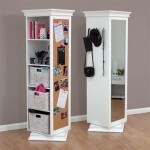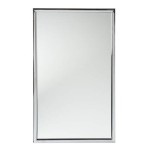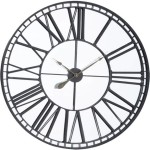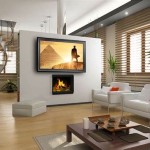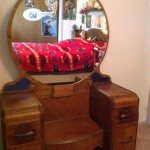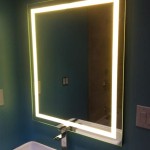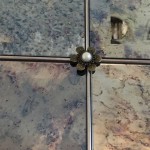Home Decorating with Mirrors: A Guide to Enhancing Space and Style
Mirrors are more than just reflective surfaces; they are versatile design elements capable of transforming the ambiance and perceived dimensions of a room. Their strategic placement and thoughtful selection can significantly contribute to a space's overall aesthetic and functionality. This article explores the diverse ways mirrors can be incorporated into home décor, highlighting their practical applications and stylistic potential.
Maximizing Light and Space
One of the most compelling benefits of using mirrors in home décor is their ability to amplify natural and artificial light. A well-positioned mirror can reflect incoming sunlight, effectively brightening a room and reducing the need for additional lighting fixtures. This is particularly beneficial in smaller spaces or rooms with limited natural light sources, such as hallways or interior rooms.
The reflective quality of mirrors also creates the illusion of increased space. By reflecting the surrounding environment, a mirror visually expands the room's boundaries, making it feel larger and more open. This can be especially effective in compact apartments or homes where maximizing the perceived square footage is essential. A large mirror placed on a wall opposite a window or doorway can significantly alter the spatial perception, making the room feel more airy and expansive.
Specific placement strategies can further enhance these effects. For instance, a long, narrow mirror placed horizontally along a wall can visually widen a narrow hallway. Conversely, a tall, vertical mirror can create the illusion of higher ceilings, making a room feel more grand and spacious. Experimentation with different sizes, shapes, and placements is key to achieving the desired effect in a particular space.
Beyond natural light, mirrors also effectively reflect artificial light from lamps, sconces, and chandeliers. This can add depth and dimension to a room's lighting scheme, creating a more layered and visually interesting effect. A strategically placed mirror can bounce light into dark corners or highlight specific architectural features, enhancing the overall ambiance of the space.
Selecting the Right Mirror Style and Frame
The style of a mirror should complement the existing décor of the room. Mirrors are available in a wide range of styles, from ornate and traditional to sleek and modern, allowing for seamless integration into any design scheme. The frame, in particular, plays a crucial role in determining the mirror's overall aesthetic appeal.
For traditional interiors, ornate frames made of wood, metal, or resin can add a touch of elegance and sophistication. These frames often feature intricate carvings, gilded finishes, or antique detailing, contributing to a sense of timeless charm. In contrast, modern interiors typically benefit from minimalist frames made of metal, glass, or frameless designs. These sleek and understated options create a clean and contemporary look.
The shape of the mirror is another important consideration. Rectangular mirrors are versatile and can be used in a variety of settings, while round mirrors add a softer, more organic touch. Oval mirrors offer a classic and elegant aesthetic, while square mirrors provide a more geometric and modern feel. Irregularly shaped mirrors can serve as unique focal points, adding a touch of artistic flair to the space. The size of the mirror should be proportionate to the wall and the surrounding furniture, ensuring a balanced and harmonious composition.
The choice of framing material can also influence the overall durability and maintenance requirements of the mirror. Wood frames offer a warm and natural aesthetic but may require periodic refinishing to maintain their appearance. Metal frames are generally more durable and resistant to damage, while frameless mirrors are easy to clean and maintain. The selection of framing materials should be based on both aesthetic preferences and practical considerations.
Functional and Decorative Applications in Different Rooms
Mirrors can be incorporated into various rooms throughout the home, serving both functional and decorative purposes. Each room presents unique opportunities to utilize mirrors in creative and effective ways.
In the bathroom, mirrors are essential for grooming and hygiene. A large mirror above the vanity provides ample reflection for tasks such as shaving, applying makeup, and styling hair. Consider adding a lighted mirror or vanity mirror with built-in magnification for enhanced visibility. Smaller decorative mirrors can also be used to add visual interest to the bathroom walls.
The living room offers numerous opportunities for incorporating decorative mirrors. A large statement mirror above the fireplace or sofa can serve as a focal point, drawing attention to the room's architectural features. Smaller mirrors can be grouped together to create a gallery wall, adding texture and depth to the space. A floor-length mirror can be placed in a corner to reflect light and create the illusion of more space. The style of mirrors chosen should complement the living room's overall design aesthetic.
In the bedroom, mirrors can be used to enhance the sense of space and add a touch of glamour. A full-length mirror is a practical addition, allowing for easy outfit checks. A dresser mirror can be paired with a vanity for a dedicated grooming area. Smaller decorative mirrors can be used to add visual interest to the bedroom walls or to reflect light from a nearby window. Consider using mirrored furniture, such as nightstands or dressers, to further enhance the sense of space and light.
Entryways benefit greatly from the addition of mirrors. A mirror near the entrance allows for quick appearance checks before leaving the house. It also helps to brighten the space and make it feel more welcoming. A small table or console beneath the mirror can provide a convenient spot for keys, mail, and other essentials. The mirror's style should complement the entryway's overall design, creating a cohesive and inviting atmosphere.
In dining rooms, mirrors can create a more formal and elegant atmosphere. A large mirror on the wall behind the dining table can reflect the candlelight and create a romantic ambiance. Smaller decorative mirrors can be used to accent the walls or to reflect artwork and other decorative elements. Consider using a mirrored buffet or sideboard to add a touch of glamour to the dining room.
Mirror Placement Considerations
Strategic placement is crucial for maximizing the benefits of mirrors. The angle at which a mirror is positioned and the objects it reflects significantly impact its effectiveness in enhancing light, space, and overall aesthetic appeal.
Avoid placing mirrors directly opposite clutter or unsightly views. Instead, position them to reflect desirable elements such as natural light, greenery, or attractive architectural features. A mirror reflecting a window with a pleasant outdoor view can effectively bring the outside in, enhancing the connection to nature and creating a more serene atmosphere.
Consider the height at which the mirror is mounted. The ideal height will depend on the mirror's size and function. For a large wall mirror, the center should be at eye level for most people. For a mirror above a vanity, the height should be adjusted to ensure comfortable visibility for grooming tasks.
Be mindful of potential glare and reflections that might be distracting or uncomfortable. Avoid placing mirrors in direct sunlight, as this can create excessive glare and overheat the room. Similarly, avoid positioning mirrors in areas where they might reflect television screens or other sources of glare.
Experiment with different angles and placements to find the optimal configuration for each room. Try moving the mirror around to see how it affects the light and space. Pay attention to the reflections and adjust the placement accordingly to achieve the desired effect.

How To Decorate With Mirrors Decorating Ideas For

Styling Mirrors How To Decorate With Around The Home

How To Decorate With Mirrors Decorating Ideas For

Mirror Decoration For Home 15 Ideas To Decorate With Mirrors

Mirror Décor Ideas How To Decorate With Mirrors

Mirror Décor Ideas How To Decorate With Mirrors

25 Wall Mirror Decorating Ideas That Will Enhance Your Home Decor
:max_bytes(150000):strip_icc()/271472936_448833010206975_537439852377940153_n-b9669f5540da4432b46151451e03f4e0.jpg?strip=all)
Expert Tips For Decorating With Mirrors

5 Decorating Ideas With Mirrors Advice Lamps Plus

10 Ideas For Decorating With Mirrors Stance Studies On The Family Living Room Decor Wall

